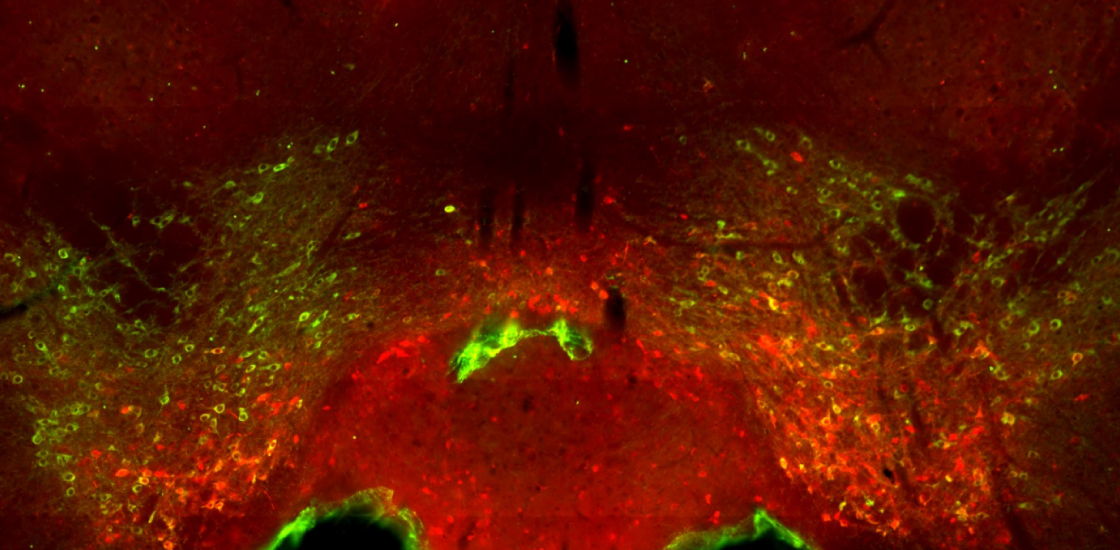Mice missing a copy of the autism-linked gene PTEN show a reduced preference for social interaction, possibly due to atypically large, overconnected dopamine neurons, according to a new study. Easing the overconnection may alleviate this trait, the researchers say.
The team presented the unpublished findings virtually yesterday at the 2021 Society for Neuroscience Global Connectome. (Links to abstracts may work only for registered conference attendees.)
Social challenges are a core autism trait, and previous work has attributed reduced social behavior in another autism mouse model to dulled activity in dopamine neurons. For mice with mutations in PTEN, though, excessive connections between dopamine neurons in two brain areas may prompt their predilection for solitude instead.
Researchers used the three-chambered social approach task to compare sociability levels in wildtype mice with those of mice missing a copy of PTEN. In this test, a mouse is placed in a central chamber with two other chambers branching off of it. One chamber contains another mouse, and the other contains an object or is empty. Mice with two intact copies of the gene showed a strong preference for the chamber with another mouse in it, whereas those missing a copy of PTEN spent equal time in the two side chambers.
The team hypothesized that the loss of this gene disrupts the social-reward circuity in the mice’s brains, making them less motivated to interact with others.
Too much connection:
Dopaminergic neurons extend from the ventral tegmental area, which is central to encoding and processing rewards, to several brain regions, including the medial prefrontal cortex, involved in social behavior and cognition.
The protein that PTEN encodes helps limit the overgrowth of cells — one of the body’s defenses against cancer. When a person or mouse is missing a copy of PTEN, it can lead to cell proliferation and sometimes tumors or macrocephaly (enlarged head size).
The team suspected that in mice missing a copy of PTEN, this dysregulated signaling leads to excessive growth of dopaminergic neurons, which cell staining revealed to be true in the ventral tegmental area. When the researchers traced the neurons’ axons — or projections — in the medial prefrontal cortex, they found that the deeper layers of the region contained denser concentrations of these fibers in the PTEN mice compared with wildtype mice.
“This is kind of exciting, and it perhaps suggests that increased axon fiber density in the deeper layers may be responsible for the social deficit in these animals,” said presenter Alex Lish, a graduate student at Harvard University who conducted the study as an undergraduate summer research fellow in senior researcher Damon Page’s lab at Scripps Research in Jupiter, Florida.
Dampening signals:
To determine whether reducing this overconnectivity between the ventral tegmental area and medial prefrontal cortex could alleviate the mice’s social behavior differences, the researchers used viral vectors to make the neurons connecting the regions express a designer protein. They then administered a drug that specifically binds to this protein to lower neuron activity.
On average, after they received the drug, mice missing a copy of PTEN showed a slightly greater preference for another mouse in the three-chamber test than before. It is possible that the treatment was not entirely successful in some of the mice, though, Lish says: Some showed the same social preferences as wildtype mice, whereas some showed no change in behavior.
This research is consistent with other work that points to the medial prefrontal cortex as a crucial mediator of multiple brain circuits that govern social behavior, and as a potential nexus for modulating these circuits to ease autism traits. It also points to dysfunction in the brain’s reward circuitry as a possible factor underlying autistic people’s social difficulties.
Read more reports from the 2021 Society for Neuroscience Global Connectome.






